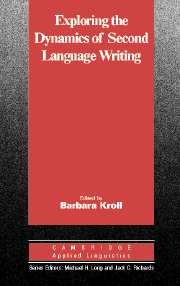Book contents
- Frontmatter
- Contents
- List of contributors
- Acknowledgments
- List of abbreviations used
- Series editors' preface
- Introduction: Teaching the next generation of second language writers
- I EXPLORING THE FIELD OF SECOND LANGUAGE WRITING
- II EXPLORING THE VOICES OF KEY STAKEHOLDERS:TEACHERS AND STUDENTS
- III EXPLORING WRITERS' FINISHED TEXTS
- IV EXPLORING CONTEXTUALITIES OF TEXTS
- Chapter 8 Genre and ESL/EFL composition instruction
- Chapter 9 Changing currents in contrastive rhetoric: Implications for teaching and research
- Chapter 10 Reading and writing relations: Second language perspectives on research and practice
- Chapter 11 Literature in the teaching of second language composition
- V EXPLORING TECHNOLOGY
- EPILOGUE: EXPLORING OURSELVES
- Index
Chapter 9 - Changing currents in contrastive rhetoric: Implications for teaching and research
Published online by Cambridge University Press: 05 October 2012
- Frontmatter
- Contents
- List of contributors
- Acknowledgments
- List of abbreviations used
- Series editors' preface
- Introduction: Teaching the next generation of second language writers
- I EXPLORING THE FIELD OF SECOND LANGUAGE WRITING
- II EXPLORING THE VOICES OF KEY STAKEHOLDERS:TEACHERS AND STUDENTS
- III EXPLORING WRITERS' FINISHED TEXTS
- IV EXPLORING CONTEXTUALITIES OF TEXTS
- Chapter 8 Genre and ESL/EFL composition instruction
- Chapter 9 Changing currents in contrastive rhetoric: Implications for teaching and research
- Chapter 10 Reading and writing relations: Second language perspectives on research and practice
- Chapter 11 Literature in the teaching of second language composition
- V EXPLORING TECHNOLOGY
- EPILOGUE: EXPLORING OURSELVES
- Index
Summary
Broadly considered, contrastive rhetoric examines differences and similarities in writing across cultures. The underlying premise of the field is that any given language is likely to have written texts that are constructed using identifiable discourse features, and these features may differ across languages or be coded using different linguistic configurations. Contrastive rhetoric dates back to the seminal work of Robert Kaplan, whose early work within an applied linguistics framework (Kaplan, 1966) suggested that to the degree that language and writing are cultural phenomena, different cultures have different rhetorical tendencies. Furthermore, Kaplan's early work, arising out of an extensive examination of writing produced by university students of English as a second language (ESL), focused on the claim that the linguistic patterns and rhetorical conventions of a first (or native) language (L1) often transfer to writing in ESL and thus cause interference. Although mainly concerned in its first 20 years with student essay writing, today contrastive rhetoric contributes to knowledge about preferred patterns of writing with the goal of helping teachers and students (and writers) around the world in many situations, especially as regards English for specific purposes.
Undeniably, in its first decades, contrastive rhetoric has had an appreciable impact on our understanding of cultural differences in writing, and it continues to spawn interest internationally with such venues as the biennial International Conference on Contrastive Rhetoric at the American University of Cairo and a roundtable seminar on contrastive rhetoric, titled “Contrastive Rhetoric in the 21st Century,” organized by Paul Kei Matsuda and me, following Purdue University's third international conference on second-language (L2) writing in October 2002.
Information
- Type
- Chapter
- Information
- Exploring the Dynamics of Second Language Writing , pp. 218 - 241Publisher: Cambridge University PressPrint publication year: 2003
Accessibility standard: Unknown
Why this information is here
This section outlines the accessibility features of this content - including support for screen readers, full keyboard navigation and high-contrast display options. This may not be relevant for you.Accessibility Information
- 16
- Cited by
